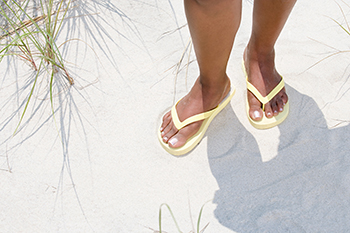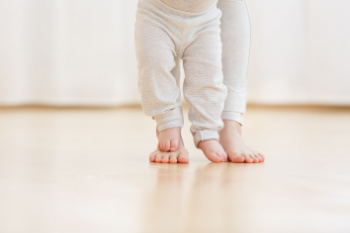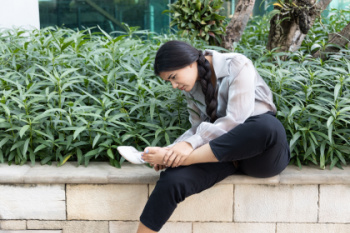Connect With Us
Blog
Items filtered by date: September 2024
The Impact of Flip-Flops on Foot Biomechanics and Gait

Flip-flops, while popular for their convenience and comfort, can negatively affect foot biomechanics and gait. These minimalistic shoes offer limited support and cushioning, leading to poor alignment of the foot and increased stress on the muscles and joints. The lack of arch support and cushioning can cause abnormal gait patterns, such as overpronation or supination, which may result in foot pain or discomfort. Additionally, the loose fit of flip-flops requires constant gripping with the toes to keep them on, which can strain the foot muscles and contribute to imbalance. Over time, frequent use of flip-flops may worsen existing foot problems or lead to new issues such as plantar fasciitis or metatarsalgia. If you have developed one or more foot conditions from wearing flip-flops, it is suggested that you consult a podiatrist for effective treatment.
Flip-flops are not always the best choice of footwear. If you have any concerns about your feet or ankles, contact one of our podiatrists from Palm Beach Foot & Ankle. Our doctors will assist you with all of your foot and ankle needs.
Flip-Flops and Feet
When the weather starts warming up, people enjoy wearing flip-flops. Flip-flops are comfortable, stylish, and easy to slip on and off; they're perfect for any summer beach goer. However, these shoes can cause harm to the feet.
How Can Flip-Flops Affect Me Long-Term?
- Ankle problems
- Hip problems
- Lower back problems
- Pain in the balls of the feet
- Problems with foot arches
- Changes in the way you walk
Are There Injuries Associated with Flip-Flops?
Yes. Since flip-flops are relatively weak and do not provide the same amount of support as sneakers, people who wear flip-flops regularly are more susceptible to injuries. On top of that, the open nature of the shoe makes your feet more prone to other problems, such as cuts and even infections. Common injuries and ailments include:
- Sprained ankles
- Blisters
- Infections
- Cuts and Scrapes
I like Wearing Flip-Flops. Are There Safe Alternatives?
When buying flip-flops, try to find ones that have sturdy soles and that are made of high-quality materials that will support for your feet. These flip-flops will cost more but will also last longer as a result.
If you have any questions please feel free to contact our offices located in Boynton Beach, Palm Beach Gardens, and West Palm Beach, FL . We offer the newest diagnostic and treatment technologies for all your foot and ankle needs.
Heel Pain Can Be Treated!
Foot Pain Caused by Sesamoiditis

Sesamoiditis is a condition that causes pain beneath the base of the big toe. It is primarily due to inflammation or injury to the sesamoid bones, which are two small bones located under the first metatarsal head. Sesamoiditis is common among dancers, joggers, people with high-arched feet, or those who frequently wear high heels. The pain associated with sesamoiditis often intensifies during activities like walking, especially when barefoot or wearing certain shoes. It may be accompanied by swelling, warmth, or redness in the affected area. A podiatrist can diagnose sesamoiditis through a thorough examination of the foot, sometimes using imaging tests to rule out fractures or arthritis. Treatment typically involves reducing pressure on the sesamoid bones through the use of orthotics, offloading pads, or appropriately supportive footwear. If you are experiencing pain under the big toe, it is suggested that you schedi;e an appointment with a podiatrist for an exam, diagnosis, and treatment options.
Sesamoiditis is an unpleasant foot condition characterized by pain in the balls of the feet. If you think you’re struggling with sesamoiditis, contact one of our podiatrists of Palm Beach Foot & Ankle. Our doctors will treat your condition thoroughly and effectively.
Sesamoiditis
Sesamoiditis is a condition of the foot that affects the ball of the foot. It is more common in younger people than it is in older people. It can also occur with people who have begun a new exercise program, since their bodies are adjusting to the new physical regimen. Pain may also be caused by the inflammation of tendons surrounding the bones. It is important to seek treatment in its early stages because if you ignore the pain, this condition can lead to more serious problems such as severe irritation and bone fractures.
Causes of Sesamoiditis
- Sudden increase in activity
- Increase in physically strenuous movement without a proper warm up or build up
- Foot structure: those who have smaller, bonier feet or those with a high arch may be more susceptible
Treatment for sesamoiditis is non-invasive and simple. Doctors may recommend a strict rest period where the patient forgoes most physical activity. This will help give the patient time to heal their feet through limited activity. For serious cases, it is best to speak with your doctor to determine a treatment option that will help your specific needs.
If you have any questions please feel free to contact our offices located in Boynton Beach, Palm Beach Gardens, and West Palm Beach, FL . We offer the newest diagnostic and treatment technologies for all your foot and ankle needs.
Common Foot Problems in Children

Children are often active and growing rapidly, which makes them susceptible to a variety of foot problems. Some of the most frequently seen issues include flat feet, plantar warts, ingrown toenails, and Sever’s disease. Flat feet occur when the arches do not develop properly, leading to discomfort or pain, especially during physical activities. Although many children outgrow this condition, some may need supportive footwear or orthotics. Plantar warts, caused by a viral infection, often develop on the soles of the feet and can be painful. These warts are common in children who frequently walk barefoot in public places like pools or locker rooms. Ingrown toenails, where the nail grows into the skin, can cause significant pain and even infection. This is often due to improper nail trimming or wearing tight shoes. Sever’s disease is a common cause of heel pain in growing children, resulting from inflammation of the growth plate in the heel. Rest and proper footwear are key to managing this condition. If your child suffers from a foot problem, it is suggested that you schedule an appointment with a podiatrist, a specialist who treats various conditions related to the feet and ankles.
The health of a child’s feet is vital to their overall well-being. If you have any questions regarding foot health, contact one of our podiatrists of Palm Beach Foot & Ankle. Our doctors can provide the care you need to keep you pain-free and on your feet.
Tips for Keeping Children's Feet Healthy
- Make sure their shoes fit properly
- Look for any signs of in-toeing or out-toeing
- Check to see if they have Clubfoot (condition that affects your child’s foot and ankle, twisting the heel and toes inward) which is one of the most common nonmajor birth defects.
- Lightly cover your baby’s feet (Tight covers may keep your baby from moving their feet freely, and could prevent normal development)
- Allow your toddler to go shoeless (Shoes can be restricting for a young child’s foot)
- Cut toenails straight across to avoid ingrown toenails
- Keep your child’s foot clean and dry
- Cover cuts and scrapes. Wash any scratches with soap and water and cover them with a bandage until they’ve healed.
If you have any questions, please feel free to contact our offices located in Boynton Beach, Palm Beach Gardens, and West Palm Beach, FL . We offer the newest diagnostic and treatment technologies for all your foot care needs.
Managing Diabetic Foot Blisters

Diabetic foot blisters, also known as diabetic bullae, are a rare but concerning complication for those managing diabetes. These fluid-filled blisters often appear on the feet, though they can also develop on the hands, arms, or lower legs. While their exact cause remains unclear, uncontrolled blood sugar levels and diabetic neuropathy are believed to be contributing factors. Diabetic blisters are typically painless and can appear suddenly without warning, sometimes growing as large as three inches. Although they sometimes heal on their own within a few weeks, there is a significant risk of infection if not cared for properly. This is why it is essential to seek medical help rather than attempting self-treatment. A podiatrist can provide safe and sterile treatment, ensuring that the blisters remain clean and protected, while also addressing any underlying issues that may be causing them. If you have diabetes and have developed foot blisters, it is suggested that you schedule an appointment with a podiatrist who can guide you toward the correct treatment.
Blisters are prone to making everyday activities extremely uncomfortable. If your feet are hurting, contact one of our podiatrists of Palm Beach Foot & Ankle. Our doctors can provide the care you need to keep you pain-free and on your feet.
Foot Blisters
Foot blisters develop as a result of constantly wearing tight or ill-fitting footwear. This happens due to the constant rubbing from the shoe, which can often lead to pain.
What Are Foot Blisters?
A foot blister is a small fluid-filled pocket that forms on the upper-most layer of the skin. Blisters are filled with clear fluid and can lead to blood drainage or pus if the area becomes infected.
How Do Blisters Form?
Blisters on the feet are often the result of constant friction of skin and material, usually by shoe rubbing. Walking in sandals, boots, or shoes that don’t fit properly for long periods of time can result in a blister. Having consistent foot moisture and humidity can easily lead to blister formation.
Prevention & Treatment
It is important to properly care for the affected area in order to prevent infection and ease the pain. Do not lance the blister and use a Band-Aid to provide pain relief. Also, be sure to keep your feet dry and wear proper fitting shoes. If you see blood or pus in a blister, seek assistance from a podiatrist.
If you have any questions, please feel free to contact our offices located in Boynton Beach, Palm Beach Gardens, and West Palm Beach, FL . We offer the newest diagnostic and treatment technologies for all your foot care needs.

